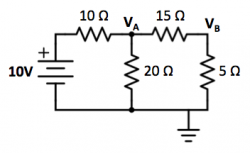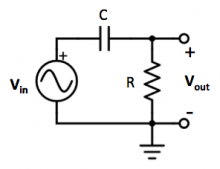Difference between revisions of "Assignment 6, Part 1: Pre-lab questions"
Juliesutton (Talk | contribs) |
Juliesutton (Talk | contribs) (→Question 2) |
||
| Line 26: | Line 26: | ||
{{Template:Assignment Turn In|message = Referring to the circuit shown below, what value of <math>R_L</math> (in terms of <math>R_1</math> and <math>R_2</math>) will result in the maximum power being dissipated in the load? | {{Template:Assignment Turn In|message = Referring to the circuit shown below, what value of <math>R_L</math> (in terms of <math>R_1</math> and <math>R_2</math>) will result in the maximum power being dissipated in the load? | ||
}} | }} | ||
| − | Hint: this is much easier to do if you first remove the load, and calculate the equivalent Thevenin output resistance <math>R_T</math> of the divider looking into the node labeled <math>V_{out}</math>. Then express <math>R_L</math> for maximal power transfer in terms of <math>R_T</math>. | + | Hint: this is much easier to do if you first remove the load, and calculate the equivalent Thevenin output resistance <math>R_T</math> of the divider looking into the node labeled <math>V_{out}</math> (the [[Electronics primer]] has a section on Thevenin Equivalent circuits). Then express <math>R_L</math> for maximal power transfer in terms of <math>R_T</math>. |
[[Image: VoltageDivider.jpg|center|200px|thumb|A voltage divider formed by <math>R_1</math> and <math>R_2</math> driving a resistive load <math>R_L</math>.]] | [[Image: VoltageDivider.jpg|center|200px|thumb|A voltage divider formed by <math>R_1</math> and <math>R_2</math> driving a resistive load <math>R_L</math>.]] | ||
Revision as of 19:07, 11 October 2017
This is Part 1 of Assignment 6.
Question 1
Consider the following circuit composed of a network of resistors:
Question 2
| |
Referring to the circuit shown below, what value of $ R_L $ (in terms of $ R_1 $ and $ R_2 $) will result in the maximum power being dissipated in the load? |
Hint: this is much easier to do if you first remove the load, and calculate the equivalent Thevenin output resistance $ R_T $ of the divider looking into the node labeled $ V_{out} $ (the Electronics primer has a section on Thevenin Equivalent circuits). Then express $ R_L $ for maximal power transfer in terms of $ R_T $.
Question 3
In the following circuit, R = 10 kΩ and C = 10 nF.
Note: You may find the pages on Impedance Analysis and Transfer Functions and Bode Plots helpful for this problem.
Back to 20.309 Main Page.



